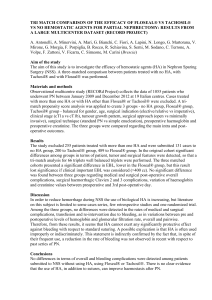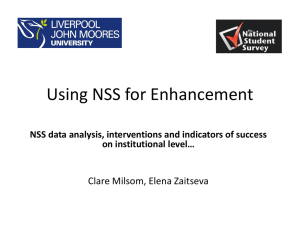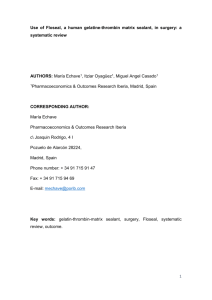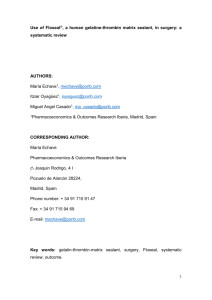RESULTS OF THE HeRo OBSERVATIONAL STUDY
advertisement
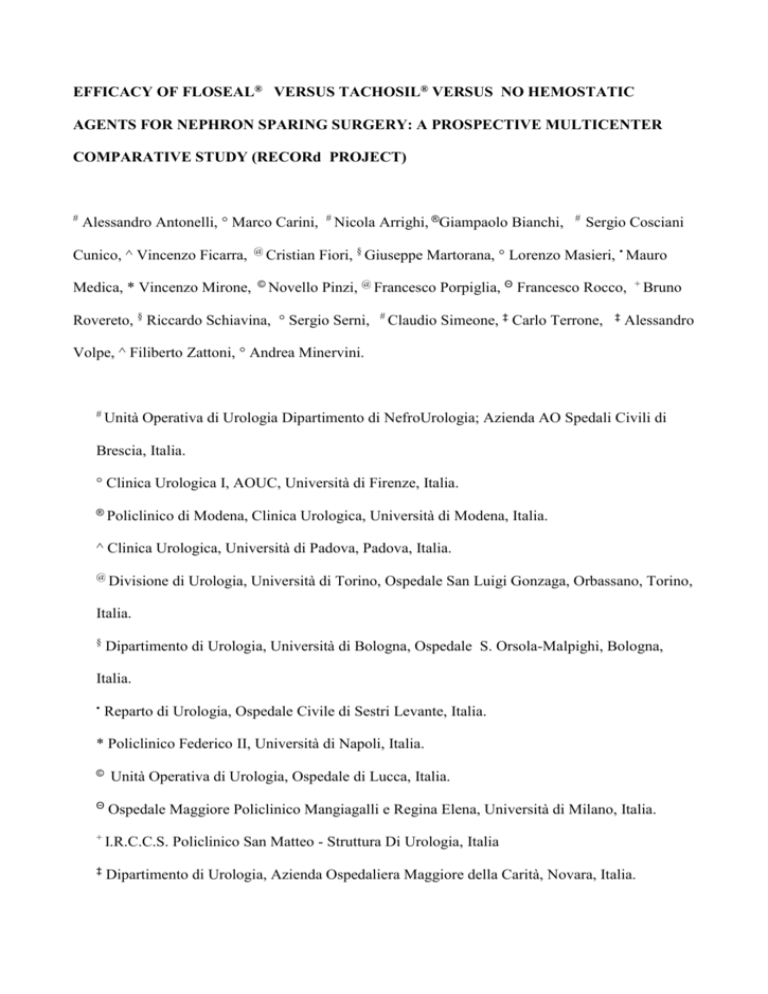
EFFICACY OF FLOSEAL® VERSUS TACHOSIL® VERSUS NO HEMOSTATIC AGENTS FOR NEPHRON SPARING SURGERY: A PROSPECTIVE MULTICENTER COMPARATIVE STUDY (RECORd PROJECT) # Alessandro Antonelli, ° Marco Carini, Cunico, ^ Vincenzo Ficarra, Medica, * Vincenzo Mirone, @ # Nicola Arrighi, ®Giampaolo Bianchi, # Sergio Cosciani Cristian Fiori, § Giuseppe Martorana, ° Lorenzo Masieri, • Mauro © Novello Pinzi, @ Francesco Porpiglia, Θ Francesco Rocco, Rovereto, § Riccardo Schiavina, ° Sergio Serni, # Claudio Simeone, ‡ Carlo Terrone, ‡ + Bruno Alessandro Volpe, ^ Filiberto Zattoni, ° Andrea Minervini. # Unità Operativa di Urologia Dipartimento di NefroUrologia; Azienda AO Spedali Civili di Brescia, Italia. ° Clinica Urologica I, AOUC, Università di Firenze, Italia. ® Policlinico di Modena, Clinica Urologica, Università di Modena, Italia. ^ Clinica Urologica, Università di Padova, Padova, Italia. @ Divisione di Urologia, Università di Torino, Ospedale San Luigi Gonzaga, Orbassano, Torino, Italia. § Dipartimento di Urologia, Università di Bologna, Ospedale S. Orsola-Malpighi, Bologna, Italia. • Reparto di Urologia, Ospedale Civile di Sestri Levante, Italia. * Policlinico Federico II, Università di Napoli, Italia. © Unità Operativa di Urologia, Ospedale di Lucca, Italia. Θ Ospedale Maggiore Policlinico Mangiagalli e Regina Elena, Università di Milano, Italia. + I.R.C.C.S. Policlinico San Matteo - Struttura Di Urologia, Italia ‡ Dipartimento di Urologia, Azienda Ospedaliera Maggiore della Carità, Novara, Italia. ABSTRACT Aim of the Study. To evaluate the efficacy of FloSeal® versus TachoSil® versus no hemostatic agents for nephron sparing surgery (NSS) in a prospective multicenter dataset. Materials and Methods. The RECORd Project is a 4-Year prospective observational multicenter study promoted by SIU. The study includes all patients who underwent open or laparoscopic NSS between January 2009 and January 2011 at 19 Italian centers. Approval of the study protocol by the local ethical committee was obtained. All intraoperative data including whether or not to clamp the renal vessels, type of haemostatic agent and intraoperative blood loss were recorded. Postoperative bleeding requiring blood transfusion/reintervention and cardiovascular complications occurring within 30 days, were recorded. Univariable analysis was used to evaluate the association between type of hemostatic agent used and both the need for blood transfusion/reintervention and the risk of cardiovascular complications. Multivariable logistic regression model was applied to analyse predictors of postoperative blood transfusion/reintervention for bleeding. Results. A total of 418 patients were recruited, following exclusion of patients with incomplete data on the type of haemostatic agent adopted and of patients treated with both haemostatic agents (FloSeal® and TachoSil®). Overall 231 had FloSeal® NSS; 116 TachoSil® NSS and 71 had pure NSS without the adoption of any haemostatic product. Clinical dimension did not differ among the three groups. Overall, 41 postoperative bleeding requiring blood transfusion/reintervention (9.8%) and 7 cardiovascular events (1.7%) occurred. Overall, 9.3% of FloSeal® NSS, 7.9% of TachoSil® NSS and 15.7% of pure NSS had postoperative bleeding requiring blood transfusion/reintervention (FloSeal® and TachoSil® vs pure, p=0.05). Moreover, 0.9% of FloSeal® NSS, 0.9% of TachoSil® NSS and 5.7% of pure NSS had cardiovascular complications (FloSeal® vs pure, p= 0.035; TachoSil® vs pure, p=0.05). Multivariate analysis showed that factors correlated with postoperative bleeding requiring blood transfusion/reintervention were preoperative haemoglobin level, ECOG score (≥1) , the lack of haemostatic agents and tumor growth pattern (>50% endphytic) while it was not influenced by the tumor location (polar vs mesorenal), the surgical approach (open vs laparoscopic), the surgical technique (Standard PN vs SE) and the decision whether or not to clamp the renal vessels. Discussion. This study represents the first prospective comparative multicenter study between FloSeal® NSS, TachoSil® NSS and pure NSS with no hemostatic agents. Conclusion. In our series the risk of postoperative bleeding was significantly and independently associated with the lack of any hemostatic agents. Both FloSeal® and TachoSil® seem protective against postoperative bleeding and are used in different settings according to tumor characteristics, surgical approach and surgeon’s attitude.
